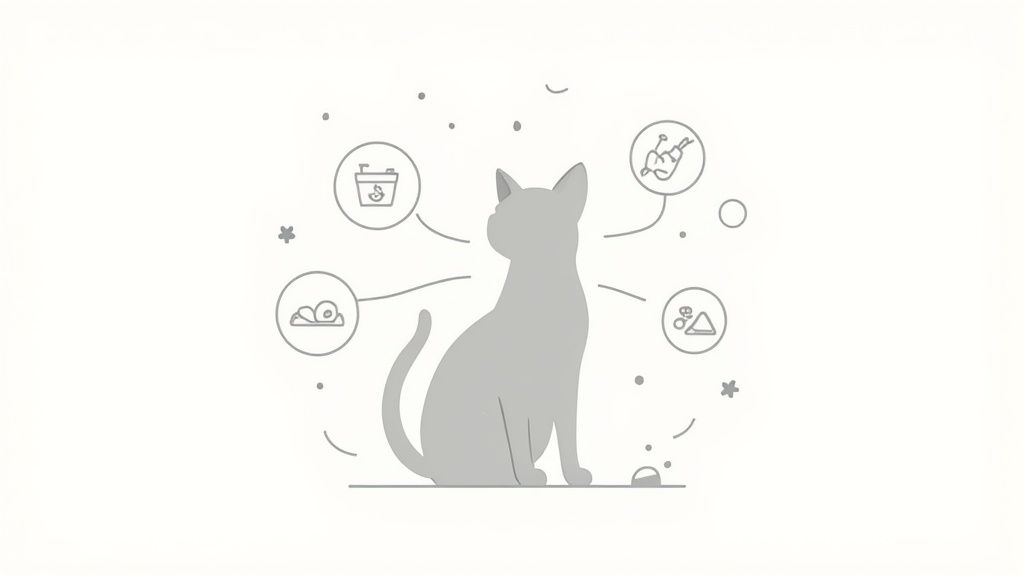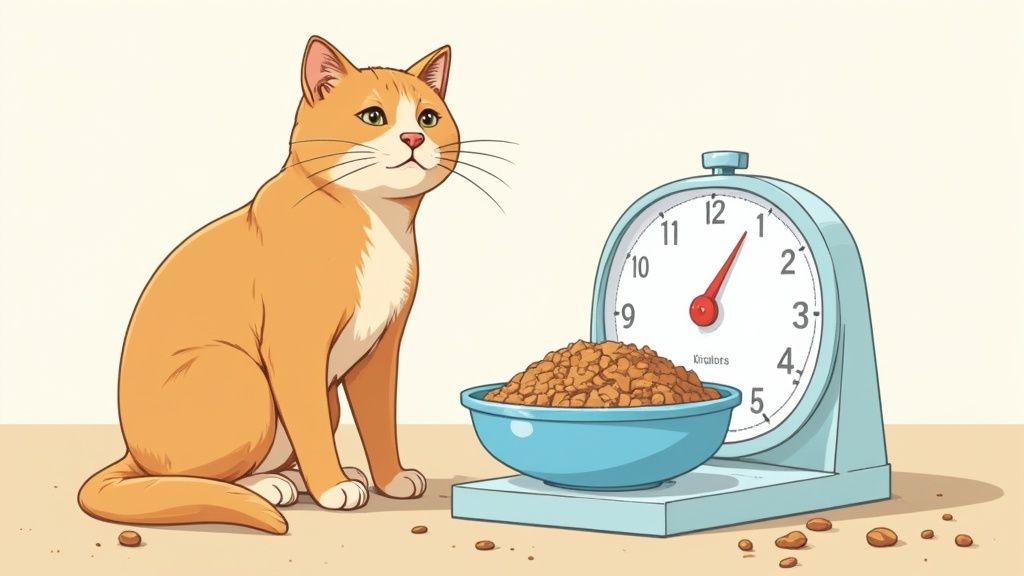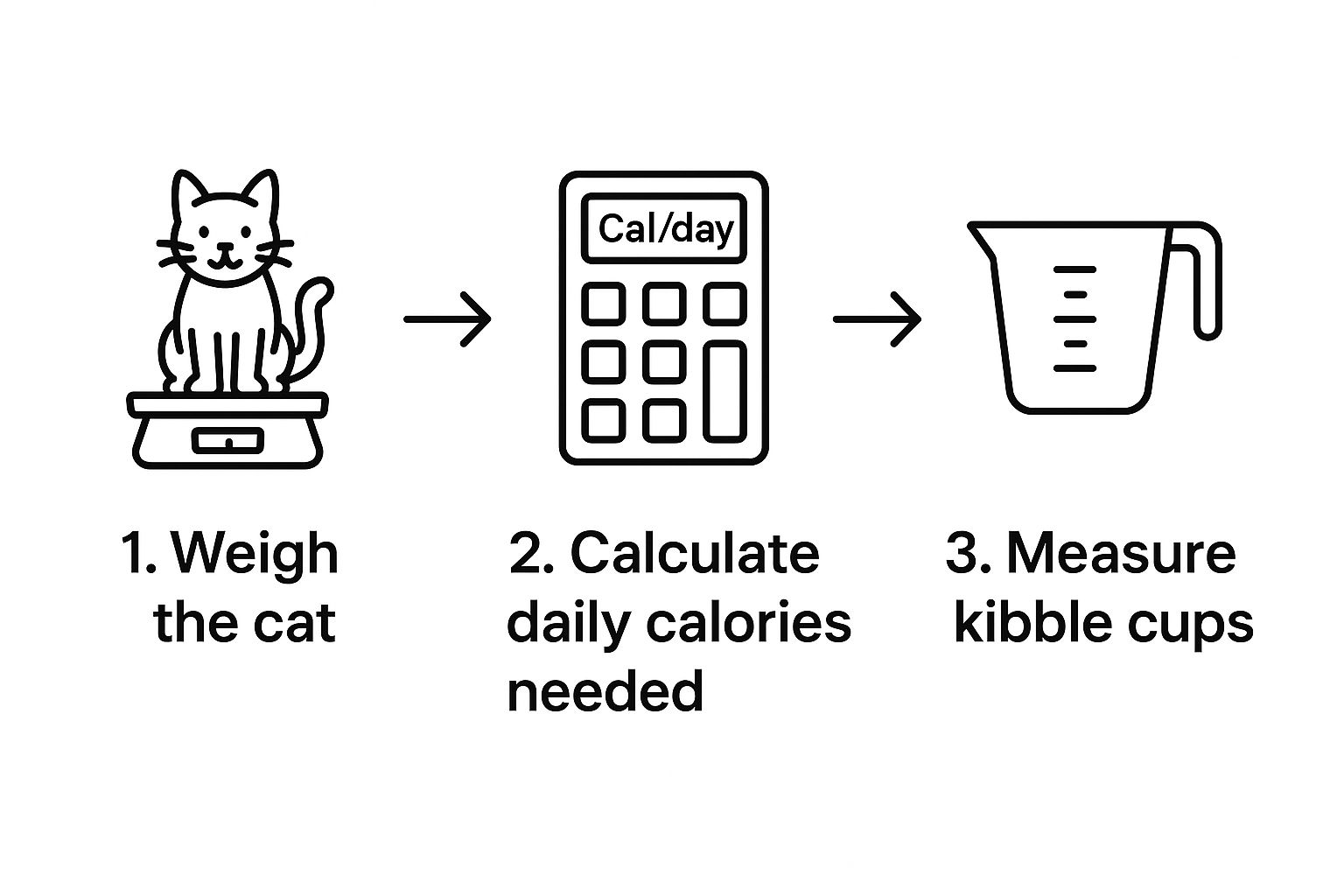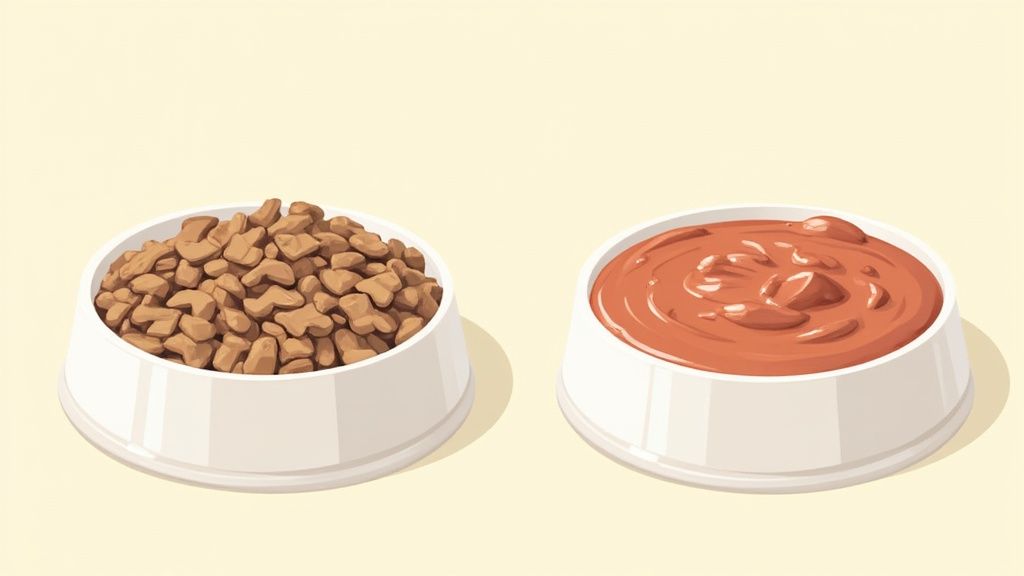How Much Dry Food to Feed a Cat The Definitive Guide
Published on September 16, 2025
If you've ever wondered how much dry food your cat actually needs, you're not alone. A good rule of thumb for a typical 10-pound adult indoor cat is about 1/2 to 2/3 of a cup of dry food per day.
But here's the catch: that's just a starting point. This amount can shift dramatically depending on the food's calorie count, your cat's age, and just how active (or lazy) they happen to be. It's crucial to look beyond the general advice and consider your cat's specific needs.
Why Cat Food Feeding Guides Are Just a Starting Point
Figuring out the right amount of dry food can feel like a guessing game. You grab the bag, find that little chart on the back, and follow it. The problem is, those charts are designed for the "average" cat, and let's be honest, is there really such a thing?
This is where a little bit of science comes in handy. The best way to get an accurate starting number is to calculate your cat’s Resting Energy Requirement (RER). This is the baseline number of calories they need just to keep their body running—think breathing, digesting, and, of course, napping.
From that baseline, we have to adjust for real life. Several factors will nudge that number up or down:
- Age and Life Stage: A playful, growing kitten needs a ton more fuel than a laid-back senior cat who has mastered the art of relaxation.
- Activity Level: Does your cat have a nightly case of the "zoomies"? They'll burn more calories than a professional couch potato.
- Spay/Neuter Status: This is a big one. Spayed or neutered cats generally have a slower metabolism and often need 20-30% fewer calories than their intact counterparts.
Dry food's popularity makes sense—it's convenient and budget-friendly. It's a huge part of why the global pet food market reached USD 133.9 billion in 2023. If you're interested, you can learn more about these market trends and their impact on future pet products.
The bottom line: The feeding chart on the bag is a generic guide, not a prescription. Your cat’s real portion size comes down to their weight, age, activity level, and the specific calorie density of their food.
To give you a practical starting point, here's a quick-reference table. It shows the approximate daily calorie needs for an average adult indoor cat and what that looks like in cups, assuming a typical dry food.
Estimated Daily Dry Food Portions for Adult Cats
| Cat's Weight (lbs) | Approximate Daily Calories (kcal) | Approximate Daily Dry Food (cups) |
|---|---|---|
| 6 | 165 | ~1/3 |
| 8 | 200 | ~1/2 |
| 10 | 240 | ~1/2 |
| 12 | 275 | ~2/3 |
| 15 | 325 | ~3/4 |
| 18 | 370 | ~1 |
Note: This table assumes a typical dry food with 400 kcal/cup. Always check your specific brand's calorie content.
Use these numbers as your initial guide. Now, let's get into the specifics of how to fine-tune this portion perfectly for your cat.
Getting to Know Your Cat's Food Label

The secret to figuring out how much dry food your cat really needs is already printed on the bag. The trouble is, most of us glance at the feeding chart on the back, which is often a vague guideline designed to work for a wide range of cats (and frankly, sell more food).
To get it right, you have to become a bit of a label detective. Your mission is to find one crucial number that cuts through all the marketing fluff.
This number is the Calorie Content. It's usually listed as "kcal/cup" or "kcal/kg." Don't let the "k" throw you; a kilocalorie (kcal) is the same thing as the calories we count in our own food. This single piece of information tells you exactly how much energy is packed into every scoop, which is far more accurate than the bag's generic weight ranges.
Think about it this way: a "light" or "weight management" formula might have 350 kcal/cup, while a food for active kittens could be loaded with 475 kcal/cup. If you used the same half-cup scoop for both, you’d be serving a vastly different number of calories. That mistake could easily lead to weight gain in one cat or leave a growing kitten hungry.
Finding the Calorie Count
Sometimes, finding the calorie count feels like a treasure hunt. It's often in small print, tucked away near the Guaranteed Analysis or the ingredient list. But once you find it, you've got the key.
Knowing your cat's daily calorie target and the food's kcal/cup value makes the math straightforward. A cat that needs 250 calories a day would get about ¾ of a cup of the 350 kcal/cup food. But for the richer 475 kcal/cup food? They'd only need a little over ½ a cup. That difference really adds up over time.
By looking past the oversized feeding chart and focusing on the kcal/cup, you take back control. It’s the single best way to make sure you’re feeding the cat you have, not some imaginary "average" cat the food company pictures.
What Else Should You Look for on the Label?
The calorie count is king for portioning, but a few other things on the label can tell you a lot about the quality of the food. It's especially helpful when you're trying to mix in other types of food. If you're debating your options, our guide on wet vs dry cat food breaks down the pros and cons of each.
Here are a few other things to check on any bag of dry food:
- AAFCO Nutritional Adequacy Statement: This is a big one. You're looking for a sentence that says something like, "[Product Name] is formulated to meet the nutritional levels established by the AAFCO Cat Food Nutrient Profiles for..." This statement confirms the food is a complete and balanced diet for a specific life stage, like "adult maintenance" or "growth."
- Guaranteed Analysis: This box gives you the bare minimums and maximums for key nutrients. It lists the minimum crude protein and fat, and the maximum fiber and moisture. Since cats are carnivores, a higher protein percentage is usually a good sign.
- Ingredient List: Ingredients are listed by weight, so whatever is first is what the food is made of most. You want to see a specific, high-quality animal protein (like "deboned chicken" or "salmon," not just "meat by-products") right at the top of the list.
Figuring Out Your Cat's Personal Calorie Count

The feeding guide on a bag of cat food is a decent starting point, but that's all it is—a start. To really nail down how much dry food your cat needs, we have to get personal. Every cat is an individual, with their own metabolism and energy level, so their portions shouldn't be one-size-fits-all.
Let's dive into a more accurate, two-part calculation that moves us from guesswork to a genuinely tailored feeding plan.
Finding the Baseline: Your Cat’s RER
The foundation of any good feeding plan is the Resting Energy Requirement, or RER. Think of it as the number of calories your cat needs just to keep their body running at a bare minimum—powering their breathing, digestion, and, of course, their professional-level napping. It's the "lights on" energy cost.
To figure out your cat's RER, you'll first need their weight in kilograms. The conversion is easy: just divide their weight in pounds by 2.2.
For example, for a 10-pound cat: 10 lbs ÷ 2.2 = 4.55 kg
Once you have their weight in kilograms, you can plug it into the standard veterinary formula:
RER (in kcal) = 70 x (cat's weight in kg)^0.75
That little exponent might look a bit scary, but don't worry. Your phone's calculator likely has a scientific mode with an "x^y" button that makes this a breeze. For our 10-pound (4.55 kg) cat, their RER comes out to about 208 kcal per day.
Remember, this is the absolute minimum for survival, not what a healthy, active cat actually needs.
Adjusting for Real Life: The Lifestyle Multiplier
Now we need to account for your cat's actual lifestyle. A tiny kitten tearing around the house has wildly different energy needs than a senior cat who has mastered the art of lounging in sunbeams. This is where the Daily Energy Requirement (DER) comes into play.
To get the DER, we simply multiply the RER we just calculated by a factor that reflects your cat's life stage and activity level. This multiplier is what transforms that baseline number into a practical, real-world calorie target. It’s the secret to customizing their diet.
This kind of personalized nutrition is becoming a huge focus for pet owners. In fact, you can see this shift in the global pet food market. According to recent research, China's pet food market is expected to grow by 6 to 8 percent by 2025, driven by demand for high-end, health-focused foods. If you're curious, you can read more about these cat food market trends to see how the industry is evolving.
Cat Lifestyle and Calorie Multipliers (DER Factors)
Finding the right multiplier for your cat is simple. Just find the description that best fits their current situation in the table below and multiply their RER by that number.
| Cat's Life Stage / Condition | Daily Calorie Multiplier (x RER) |
|---|---|
| Kitten (0-4 months) | 2.5 |
| Kitten (4-12 months) | 2.0 |
| Neutered Adult | 1.2 |
| Intact Adult | 1.4 |
| Senior (7+ years) | 1.1 |
| Weight Loss | 0.8 |
| Weight Gain | 1.8 |
As you can see, a typical neutered adult cat needs 1.2 times their RER, while a young, energetic kitten needs a whopping 2.5 times that baseline amount. This simple adjustment is the key to feeding the unique cat you have, not just the generic one on the food bag.
Let's Walk Through an Example: Feeding Leo
All these formulas and numbers can feel a bit abstract. The best way to make sense of it is to see how it works in a real-life situation. So, let’s put this all into practice.
Meet Leo. He’s a pretty typical indoor cat: a neutered male, weighs a healthy 10 pounds, and spends his days lounging, with a few energetic spurts here and there. His owners are tired of just "eyeballing" his meals and want to get it right.
Nailing Down Leo's Daily Portion
First things first, we need to figure out his basic metabolic needs—his Resting Energy Requirement, or RER. The formula uses kilograms, so we'll start there.
- 10 lbs / 2.2 = 4.55 kg
Now, we can use the RER formula: 70 x (4.55)^0.75. Don't worry, a phone calculator can handle this! It comes out to about 208 kcal per day. That’s the baseline energy his body needs just to exist.
But Leo isn't just lying in a coma. He moves around. As a neutered adult cat, we'll use a lifestyle multiplier of 1.2 to find his true Daily Energy Requirement (DER).
- 208 kcal (RER) x 1.2 (Multiplier) = 249.6 kcal per day
Let's just call it an even 250 kcal per day. That’s our target.
Next, we check the bag of his food. It says the kibble has 410 kcal per cup. Now for the final step, we just divide our target by the food's calorie density.
- 250 kcal / 410 kcal/cup ≈ 0.61 cups
That comes out to just a little over a 1/2 cup of food for the entire day. To keep him satisfied, his owners could split this into two meals—maybe a generous 1/3 cup for breakfast and the rest for dinner. This approach helps keep his metabolism humming and prevents that "I'm starving!" drama we all know so well.
This simple, three-part process is a reliable way to figure out your cat's ideal portion size.

As you can see, it boils down to weighing your cat, doing a quick calculation for their daily calories, and then measuring out the food accurately.
The Bigger Picture: Customization is Key
This kind of personalized feeding is becoming the new standard for conscientious pet owners. You can see this shift reflected in the pet food industry itself, with a growing trend toward highly customized diets. Brands are now creating foods for specific breeds, ages, and lifestyles, which changes the game for how we feed our cats. If you're curious, you can discover more insights about these pet food market reports and see how these trends are shaping our choices.
Key Takeaway: Ditching the generic feeding chart on the bag and using your cat’s specific RER and DER is the single best thing you can do for their long-term health. Grab a kitchen scale and a good measuring cup—they are your most valuable tools for getting it right every single day.
When and How to Adjust Your Cat's Portions

The feeding plan you've carefully calculated is a great starting point, but it's not set in stone. A cat's body is constantly changing, and so are its dietary needs. The real skill is learning to read your cat's body and know when it's time to tweak their daily kibble.
Vets don't just rely on the number on a scale. We use a hands-on tool called the Body Condition Score (BCS), and it's something you can easily learn to do at home. It’s a much better way to get the full picture of your cat's health.
Using the Body Condition Score
The BCS is a nine-point scale where a 5 is the sweet spot—absolutely ideal. A score of 1 is dangerously thin, while a 9 is obese. You don’t need to be a pro to get a general idea of where your cat lands.
Here’s a quick check you can do right now:
- Feel the Ribs: Gently run your hands along your cat's sides. You should be able to feel their ribs under a thin layer of fat, kind of like feeling the back of your own hand. If you have to dig to find them, your cat is likely carrying extra weight. If the ribs feel sharp and obvious, they may be underweight.
- Check the Waistline: Look down at your cat from above. You're looking for a subtle hourglass shape—a slight tuck behind the ribs. If their body looks more like an oval with no real waist, that’s a sign they’re a bit too heavy.
- Look at the Tummy Tuck: Now, look at your cat from the side. Their belly should slope gently upward from the end of their ribcage to their hind legs. A sagging belly that sways when they walk is a classic sign of excess fat.
A healthy cat has a visible waist when viewed from above and a slight abdominal tuck when viewed from the side. Their ribs should be easy to feel but not sharply visible.
These simple checks are your best guide for deciding if your current portions are hitting the mark.
Making Safe and Gradual Adjustments
So, what do you do if you find your cat is a little too plump or a bit too lean? The key is to make changes slowly. Drastic cuts can stress their system and even be dangerous.
The golden rule is to adjust their daily food intake by about 10%.
Let's say you're currently feeding half a cup of food, which is around 200 kcal. A 10% reduction would be just 20 kcal. That’s only a small handful of kibble—a change so small your cat will barely notice, but one that makes a real difference over time. This small shift is usually enough to get them heading back toward their ideal weight without making them feel hungry or deprived.
Other Clues to Watch For
Your cat's body shape isn't the only thing that can tell you a diet adjustment is needed. Pay attention to their overall well-being, too.
Keep an eye out for these subtle hints:
- Energy Levels: Has your normally zippy cat turned into a couch potato? Or is your older cat suddenly pacing and restless? Big shifts in energy can be tied directly to their calorie intake.
- Coat Condition: A healthy diet produces a soft, shiny coat. If your cat’s fur starts looking dull, flaky, or greasy, it could be a sign that something is off with their nutrition.
Once you’ve made a 10% adjustment, stick with the new amount for at least a month. This gives their body time to respond. After that, do another Body Condition Score check to see your progress. This cycle of observing, adjusting, and re-checking is the best way to keep your cat at a healthy weight for their entire life.
Answering Your Top Cat Feeding Questions
Even after you've done all the math, real-life questions always come up. I get asked about cat feeding all the time, and a few topics seem to pop up again and again. Let's dig into some of the most common puzzles cat owners face.
Should I Free-Feed or Set Meal Times?
This is probably the biggest debate out there. Is it better to leave a full bowl of kibble out all day, or serve distinct meals?
Free-feeding, where food is available 24/7, is certainly convenient for us humans. The problem is, it's often a disaster for a cat's waistline. Most cats, especially those living indoors, just don't have the self-control to graze lightly. They'll often eat out of boredom, which quickly leads to weight gain.
Scheduled meals, on the other hand, put you in the driver's seat. Serving food two or three times a day gives you total control over their calorie intake. It also helps regulate their metabolism and makes it immediately obvious if their appetite suddenly drops off—which can be one of the first signs of a health issue.
How to Switch to a New Dry Food
So, you've found a higher-quality kibble or your vet recommended a special diet. Great! But don't just swap the food overnight. A sudden change is a surefire recipe for an upset stomach.
The key is a slow and steady transition. I always recommend taking at least a week, sometimes longer.
- Days 1-3: Start with a mix of 75% old food and 25% new food.
- Days 4-6: Move to a 50/50 split of old and new.
- Days 7-9: Now, you can shift the balance to 25% old and 75% new.
- Day 10: Your cat should be ready for 100% of the new food.
Keep a close eye on the litter box during this process. If you see any signs of digestive trouble, just slow the transition down and give their system more time to adjust.
What if My Cat Acts Hungry All the Time?
It’s tough when your cat follows you around, meowing for more food right after a meal. Before you give in and add another scoop to the bowl, let's consider what might really be going on.
Often, what we see as hunger is actually boredom. This is especially true for indoor cats who lack the stimulation of the outdoors. A puzzle feeder or a food-dispensing toy can be a game-changer. These tools make your cat "work" for their food, which mimics their natural hunting instincts. It slows down their eating and provides a ton of mental enrichment, which can often solve the constant begging.
A quick but important note: If your cat suddenly seems ravenous and this behavior is new, or if they're losing weight despite eating a lot, it's time for a vet visit. An overactive thyroid (hyperthyroidism) and other conditions can cause a huge spike in appetite. It's crucial to rule out any underlying medical causes.
Finding that sweet spot between high-quality nutrition and a price you can afford is a challenge every cat owner understands. At Cat Food Rankings, we've done the heavy lifting by analyzing thousands of foods based on their cost per calorie, nutritional content, and more. You can use our free, real-time data to compare brands and discover the perfect dry food for your cat and your budget at https://foodrank.pet/cat.